NEW YORK (AP) — U.S. stocks rallied after the Federal Reserve indicated it may not need to pump the brakes any harder on Wall Street and the economy. The S&P 500 rose 1.1% Wednesday. The Dow gained 221 points, and the Nasdaq composite jumped 1.6%. Treasury yields also eased in the bond market after the Fed announced its decision to hold interest rates steady, as expected. The Fed hinted that a swift rise since the summer in Treasury yields, and the resulting tumble in stock prices, may be slowing inflation on their own and acting like rate-hike substitutes.
THIS IS A BREAKING NEWS UPDATE. AP’s earlier story follows below.
NEW YORK (AP) — U.S. stocks are rallying Wednesday after the it may not need to pump the brakes any harder on Wall Street and the economy.
The S&P 500 was 1.1% higher in late trading. The Dow Jones Industrial Average was up 223 points, or 0.7%, as of 3:27 p.m. Eastern time, and the Nasdaq composite was 1.5% higher.
Stocks built on gains from earlier in the day as Treasury yields eased in the bond market after the Fed announced its decision to hold interest rates steady, which was what investors expected. The Fed has already yanked the overnight rate from nearly zero early last year to its highest level since 2001, above 5.25%.
Fed Chair Jerome Powell said in the afternoon that the central bank still isn't sure its main interest rate is high enough to ensure high inflation will move down to its 2% target. That kept alive the possibility of more hikes by the Fed. He also said that cuts to rates, which can act like steroids for financial markets, aren't even on Fed officials' minds at the moment.
But Powell acknowledged that a recent run higher in longer-term Treasury yields, and the tumble in stock prices that caused, are working on their own to slow the economy and could be starving high inflation of its fuel. If they can do that persistently, he said they could help the Fed whip inflation without requiring more rate hikes.
The jump in yields has already brought the average 30-year fixed mortgage rate to nearly 8%, for example, “and those higher costs are going to weigh on economic activity to the extent this tightening persists."
And, he said, the Fed has time to sit still on rates to assess the effects of its rate hikes after unleashing a furious barrage beginning early last year.
“It takes time, we know that, and you can’t rush it,” Powell said. “Slowing down is giving us a better sense of how much more we need to do, if we need to do more.”
Since the spring, longer-term Treasury yields have been rising rapidly and catching up with the Fed’s overnight rate. They’ve rallied as the U.S. economy has remained remarkably resilient and the central bank has warned it may keep its short-term rate high for a long time. Last month, it topped 5% to reach its highest level since 2007, up from less than 3.50% during the spring.
High yields knock down prices for stocks and other investments while making borrowing more expensive for nearly everyone. That slows the economy and puts pressure on the entire financial system.
The yield on the 10-year Treasury sank to 4.76% from 4.92% late Tuesday. Much of the drop came after the Fed gave a nod to the notion that higher bond yields and shakiness in financial markets may be slowing the economy on their own without any more hikes needed.
But yields were already falling in the morning after several reports on the economy gave a clouded view.
One report from ADP suggested hiring accelerated last month by employers outside the government, though not by as much as economists expected. A more comprehensive jobs report from the U.S. government will arrive on Friday.
A separate report said U.S. employers were advertising slightly more at the end of September than economists expected. The Fed has been hoping for softening there, which could take pressure off inflation without requiring many layoffs across the economy.
A third report, meanwhile, said U.S. manufacturing contracted by more last month than economists had forecast. Manufacturing has been one of the U.S. economy's hardest-hit areas.
In the background, big U.S. companies continue to report stronger profits for the summer than analysts expected, though that often hasn’t been enough in recent weeks to offset worries about higher yields.
DuPont fell 7.6% despite reporting stronger profit for the latest quarter than analysts had forecast. The chemical company gave some financial forecasts for the full year of 2023 that fell short of analysts’ expectations as it sees weakness in China and other challenges.
Estee Lauder also pointed to slower growth in China, among other factors, when it cut some of its financial forecasts for its fiscal year. The company also reported weaker revenue for the latest quarter than expected, and its stock tumbled 18.6.
On the winning side of Wall Street, chipmaker Advanced Micro Devices rose 9.6% after it reported stronger profit and revenue for the latest quarter than forecast. Its revenue forecast for the end of 2023 disappointed some analysts, but it also pointed to growth in 2024 coming from the artificial-intelligence boom.
An AI-fueled bonanza earlier this year helped fuel big gains for some Big Tech stocks, with expectations high that the technology could usher in mammoth profits.
Big Tech stocks were generally big winners Wednesday, along with other high-growth stocks that are seen as some of the biggest beneficiaries of easier interest rates.
Gains of 2.6% for Microsoft, 1.9% for Apple and 3.8% for Nvidia were the three strongest forces pushing the S&P 500 higher.
In stock markets abroad, indexes were mostly higher across Europe and Asia.
___
AP Business Writers Matt Ott and Elaine Kurtenbach contributed.
Stan Choe, The Associated Press



